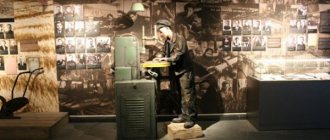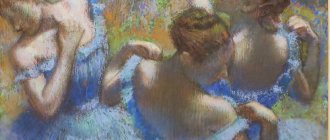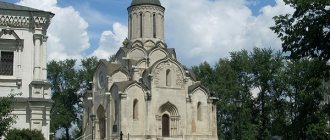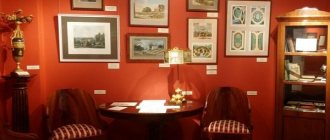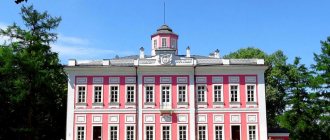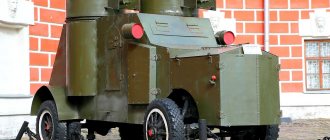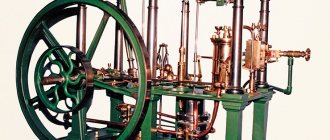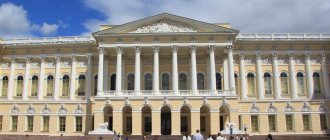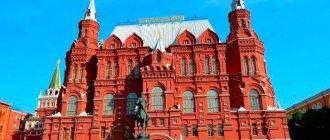Date: 8 Nov, 2021 Author: Elena Category: Weekend walks, Moscow Museums
One of the most popular and famous museums in Moscow, the Paleontological Museum, is located between the Konkovo and Teply Stan metro stations. Quite far from the center of Moscow, but such accessibility by public transport is very convenient.
We visited the Paleontological Museum on a weekday, so there weren’t very many people, except for a bunch of elementary school students who were brought on an excursion.
The museum building itself looks rather gloomy. As planned, it was built in the form of a fortress with four towers and a courtyard. Although the inside is not much more fun than the outside. The interiors and old caretakers have remained here since Soviet times. But it's warm inside. It was early November, so the weather outside was cloudy and cold. It's good that it didn't rain.
The museum's lobby contains a ticket office, a cloakroom, a couple of souvenir shops, a restroom, and a metal detector that you pass through when entering the museum.
The dinosaur hunt is open!
- Ticket prices
- How to get there?
- Opening hours
- Video about the Paleontological Museum
- Museum exposition
- Photos of the Paleontological Museum
Ticket prices and conditions for visiting the museum
Ticket prices in 2021:
A full ticket for an adult costs 400 rubles. School, student and pension - 200 rubles. And for children under 6 years old and museum employees – it’s completely free.
It is possible to book excursions: - for children; - for adults; - individual.
A complete list of excursions is available on the official website of the museum.
Their cost at the end of 2021 ranged from 3,700 to 12,000 rubles.
Photo and video shooting for the home, for the family - free of charge. We have personally seen how parents came with their child, apparently to perform some task for school, even used a tripod for filming, and no one told them anything.
Paleontological Museum: a rebus of the Brezhnev era
Project of a park around the museum. Photo: archive of Anna Gnedovskaya
One of the puzzles of stagnation and at the same time an example of what is commonly called a “gesamtkunstwerk” - a total work of art, in our case - a fusion of science, architecture and monumental art, is the building of the Moscow Paleontological Museum. Yu.A. Orlova. Work on it began in 1965, at the peak of modernist aspirations, and ended in 1987, when perestroika was in full swing. In 1993, the authors - architects and artists - received the State Prize for it. The museum was born in the crucible of stagnation, absorbed the contradictions of the era and embodied its spirit.
Today this building is a mystery. Unlike natural history museums in London, New York or Paris, ours is not located in the city center, but in an almost unattainable distance - 2 km from the Moscow Ring Road. Outwardly, it looks like a bunker - somewhat unexpected for a cultural institution. The uniqueness of our Paleontological Museum lies in the abnormal amount of monumental fine art. There are square kilometers of it: stone and bronze reliefs, ceramic panels, sculptures, monumental paintings. The introduction of art into the natural science museum was not due to a lack of exhibits. On the contrary, our paleontological collection is one of the largest in the world. Time just showed itself in such a whimsical way. A time that is now of particular interest to cultural researchers, as evidenced, for example, by the grandiose exhibition “Not Forever” that opened at the State Tretyakov Gallery. 1968–1985”, dedicated to fine arts. Afterwards, it’s a good idea to go to the Paleontological Museum to appreciate on site the achievements of Soviet muralists.
Interim project of the museum. Photo: archive of Anna Gnedovskaya
Today the museum also attracts the attention of young architects. They perceive it as a result equal to the plan, although this is not entirely true. There is a significant difference between the initial ideas and the final result. This revealed the curvature of the lens of stagnation, and it is this that is interesting to trace.
Place: science city in the South-West, or a museum at the zoo
The paleontological museum arose where it is located, as part of a grandiose development of the entire southwestern part of Moscow. The fact that the city would develop precisely to the southwest was spelled out in the General Plan of 1935. After the war, they returned to the idea and, using new methods of continuous construction, in 10–20 years they transformed the former rural wastelands behind the Vorobyovy Gory and Kaluga Outpost into a city of the future with wide avenues and uniform “no frills” houses. The main building of Moscow State University, built in 1949–1953, provided specialization for all these lands. In essence, they built a science city with research institutes, universities and libraries. On Profsoyuznaya Street alone (at the end of which the Paleontological Museum is located), in 1952–1966, according to the design of Yakov Belopolsky, the Institute of Scientific Information for Social Sciences (INION), the Central Economics and Mathematics Institute (CEMI), and the Central Medical Library were built - iconic objects of the Soviet modernism.
Museum building. Photo: Lori's photo bank
Development of the South-West dragged on until the end of the century. At some stage, the idea arose to move the Moscow Zoo to this communist paradise (more precisely, to Bitsa). Designed in the 1970s and opened in 1990, the Bitsevsky Park metro station (since 2009 - Novoyasenevskaya) had a special eastern entrance for visitors to the future zoo. Zoological and paleontological museums were adjacent to the zoo. The entire complex was supposed to be located in a green area and illustrate the history of wildlife ab ovo to the present day. In addition to purely practical tasks (to provide people, animals and exhibits with normal working, living and storage conditions, to add cultural objects to new Moscow districts), this entire complex also had a symbolic overtone, representing a visible triumph of scientific materialism - Darwinism - and communist ideology.
Collection: 120 tons of ancient lizards
The collection of the Paleontological Museum originates from the Kunstkamera of Peter I. This field of science received jet acceleration in the second half of the 19th century, during the Industrial Revolution, when mineral deposits began to be developed everywhere, geology and its important part, paleontology, became applied disciplines. The oldest paleontological society was founded in England in 1842 (at the same time the word “dinosaur” arose). In 1908, a similar society appeared in the USA, in 1912 - in Germany, in 1916 - in Russia (in 1947 - in Italy and in 1979 - in France). Russian scientists were, as they say, at the forefront: in 1899, not far from Veliky Ustyug, on the Northern Dvina River, paleontologist Vladimir Amalitsky (1860–1917) discovered the location of amazingly preserved animal-like lizards, which became a world sensation.
Ceramic panels on the walls of the museum. Photo: archive of Alexander Belashov
Paleontological museums began to be founded around the world at the turn of the 19th and 20th centuries. By that time in Russia, a paleontological exhibition existed in the Geological Museum in St. Petersburg. In 1923, she received separate premises. True, it did not exist there for long: in 1934, most of the institutions of the Academy of Sciences moved to Moscow. In 1937, the fossil remains of prehistoric organisms occupied the former stables of Count Orlov on Kaluzhskaya, 16. After the war, three expeditions to Mongolia in 1946–1949 under the leadership of the legendary Ivan Efremov, better known to the public for his science fiction novels, were epoch-making for Soviet paleontologists. Then it was possible to discover and explore unique locations of dinosaurs and ancient mammals, turtles and crocodiles. 120 tons (460 boxes) of paleontological finds were brought to Moscow! But the museum was still huddled on Kaluzhskaya, excursions came there by appointment, and since 1954 there was no free access for visitors. The need for new premises became critical.
Project: from Corbusier's legs to the Mesopotamian ziggurat
In 1965, Yuri Orlov (1893–1966), director of the Paleontological Institute of the USSR Academy of Sciences, of which the museum was a division, achieved the opening of funding - 2 million rubles were allocated for the project. Since the institution was part of the academy, another of its divisions, GIPRONIA, at that time one of the leading architectural institutes, was assigned to design the building. The team was led by Yuri Platonov (1934–2015).
Alexander Belashov (far right) is the creator of the museum’s ceramic panels. Photo: archive of Alexander Belashov
Architect Anna Gnedovskaya, the daughter of one of the museum’s authors, Valentin Kogan (1925–2006), preserved her father’s archive, and from old photographs one can trace the direction in which the author’s thought developed. At first they thought about two (and even five) separate volumes, because both the museum and the institute were to be located under one roof. The building itself was modernist, on thin legs-supports, as bequeathed by the great Le Corbusier. Then the house began to become heavier and close in on its own volume. What in the finale turned into expressive monolithic towers, at first were inverted towers - “sails”, cut through by geometric windows (hello again to Le Corbusier, his chapel in Ronchamp). As a result, we got a building similar to the Great Ziggurat at Ur (21st century BC). The parallels with the architecture of ancient Mesopotamia are also emphasized by the building material - red brick (an "elite" material in the era of panel housing construction in the USSR).
If you look at it in retrospect, stylistically the museum fit into the global post-war fashion for block houses - what is called brutalism today. In the same figurative paradigm, for example, the buildings of the Ulster Museum in Belfast (architect Francis Pym, 1964) and the Whitney Museum in New York (architects Marcel Breuer and Hamilton Smith, 1963–1966) were designed. The only difference was that Western brutalism had a modernist message: it competed with earthly gravity. It is not clear how all these masses of concrete - consoles and crooked canopies (although, of course, it is clear - with the help of reinforced concrete) were kept in the air. In the USSR, the quality of concrete work in many cases left much to be desired, which was compensated for by stone cladding. Our brutalism was about something else - about dialogue with the styles of the past. The ziggurat-like Paleontological Museum began this eclectic postmodern line. It can be considered one of the first monuments of postmodernism. Its twin - another Moscow natural science museum, Darwin, the design and construction of which lasted 45 years, from 1962 to 2007 - became the apogee of this vector, the triumph of postmodernism, an orgy of architectural quotations.
Leonid Yakovenko. Sketches of the interior of the museum. Photo: archive of Anna Gnedovskaya
Interiors: “psychological blow”
The surviving sketches of the architect Leonid Yakovenko (1941–2015), for whom the museum became his life’s work, suggest that the interior space was supposed to be an attraction (much like in today’s aquariums): halls immersed in darkness, giant illuminated display cases with animal lizards. The height of the rooms ranged from 3 to 15 m, and, as Yakovenko wrote, the viewer, getting from the low hall of amber into the vast hall with the skeleton of a saurolophus, was supposed to experience a “psychological blow.” In the center of the museum it was planned to place a winter garden under a glass roof, and sculptures - reconstructions of extinct animals - were hidden there in the tropical thickets. There were also rooms with normal light and low, horizontally elongated display cases, and they did not block the wall decor. In one place between the museum and the institute there was a glass partition - viewers could watch the work of researchers dissecting and studying future exhibits. The sculptural friezes on the walls initially looked like a slight stylization of the cave paintings of primitive people.
The foundation stone for the museum took place in 1972. They built it for 15 long years, sometimes preserving it, sometimes defrosting it. The USSR began preparations for the 1980 Olympics; there was not enough money for the museum. In addition, residents of the new Yasenevo district were against moving the zoo, and the idea was buried. As well as the winter garden inside the museum, and transparent walls between laboratories and spectators. The project drifted towards simplification, although, according to Anna Gnedovskaya, the very fact that they managed to “stretch” the volume, maintain the quality of straight walls and the complex curvature of the towers is a great victory for the architects, including her father Valentin Kogan and today the most forgotten , but also a key author, an irreplaceable private of this battle - Valentina Nagikh (1924 - the exact date of death is unknown).
Ceramic panels on the walls of the museum. Photo: archive of Alexander Belashov
Materialistic iconostasis: the triumph of ceramists
Special mention must be made about monumental art. Realizing that the architects looked up to Mesopotamia, the sculptors decided to support the story with ceramics, as on the Babylonian Ishtar Gate. The ceramic panels in the Paleontological Museum (some reaching 18 m in length) required the titanic efforts of a team led by sculptor Alexander Belashov (1933–2011) and his wife, sculptor Maria Favorskaya-Shakhovskaya (1928). They came up with a clever way of making and firing individual fragments of reliefs. Production was launched in Gzhel. The installation of the panels was carried out by tilers from Metrostroy. Neither before nor after there were museum projects of this scale in the USSR.
Monumental painting in the museum was carried out by Mai Miturich-Khlebnikov (1925–2008) and Viktor Duvidov (1932–2000). A separate study should be written about the monumental program of the museum. Let us dwell on the most remarkable object - the composition “Tree of Life” (area 468 sq. m). It occupies the inner surface of an 18-meter tower. This is the first thing the visitor sees after passing the ticket control: dozens of images of animals, many of which are life-size, the change of main eras - life in the seas, the development of land, the dominance of dinosaurs, the appearance of birds and mammals, the emergence of man. On the one hand, the picture is didactic, and on the other, conventional.
“If we strictly followed science,” recalls a participant in the events, muralist Alexander Belashov Jr. (he is the son of the project manager, at the age of 17–19 he helped his father), “then 80% of the panels should have been occupied by invertebrates: sponges, worms, shellfish And my father brought dinosaurs found in the Mongolian expedition to the center. I remember meetings with scientists - the debates were heated. We were defended by paleobotanist Dr. Sergei Meyen. He insisted that there is artistic truth and that in this case it is more important.”
Ceramic panels on the walls of the museum. Photo: archive of Alexander Belashov
The “Tree of Life” is crowned, naturally, by a person - a woman with a child (read: the Mother of God and Child). The floor and ceiling of the tower were made mirrored - the image falls into the well of time and goes into infinity. It was a kind of materialistic iconostasis. Materialism - an advanced worldview in the 17th-19th centuries - by the end of the 20th century in the USSR it turned into a ritual, and then into a cult, and eventually gave way to a real cult - Orthodoxy. The search for God was very characteristic of the era of stagnation (at the exhibition “Never Forever” a separate section is devoted to the search for God). In this regard, it is probably no coincidence that one of the architects of the project, Evgeny Katyshev, who was involved in drawing witty metal lattices of dinosaurs, camels, squids and fish, today teaches temple architecture at the Moscow Architectural Institute, and the muralist Alexander Belashov Jr. amazingly paints temples .
Dinosaur figures in the workshop of Alexander Belashov. Photo: archive of Alexander Belashov
There are two explanations for the fact that there is so much monumental art in the Paleontological Museum: rational and metaphysical. According to the first, the “monumental painting” guaranteed the architects additional income as co-authors, and they willingly used it. The metaphysical thing is that stagnation turned any living phenomenon into a monument (the author of this idea is one of the curators of the exhibition “Never Forever” Kirill Svetlyakov). The sculptor Boris Orlov even has a “Series of Monuments” - Vladislav Tretyak’s hockey stick, Alla Pugacheva’s hair... Giant reliefs, panels and paintings in the museum corrected the semantics of architecture: from a museum-laboratory a museum-memorial turned out, like Mamayev Kurgan or the Brest Fortress, which in relation to paleontological topics are somewhat tautological, because this science itself deals with the dead. Museum director Alexander Karhu disagrees with this. “Palaeontology does not deal with the “dead” - it deals with the life of past geological eras. By studying the fossilized evidence of this life and giving it names, paleontology makes it immortal,” he explains. However, this remark also takes our reflections to the plane of the transcendental.
Exhibition designers completed the formation of the museum space. They came up with tall museum display cases with “gable roofs” that hid the lighting system and fluorescent lamps. These original designs focused the viewer on the bones, sometimes obscuring the art on the walls. At the same time, this arrangement of the display cases made them look like shrines containing the relics of saints, which once again emphasized the funerary and memorial artistic subtext of the entire architectural image.
Museum halls. Photo: Lori's photo bank
A monumental secret and a forgotten treasure
The paleontological museum today is a big secret of the city of Moscow: if you don’t know where it is, it’s impossible to get into it by chance, like one of the points on a standard tourist route. It is still integrated with the Paleontological Institute. A.A. Borisyak RAS, which makes it more of an institution of science than a modern museum - a place of education through entertainment. There is still no convenient cafe or souvenir shop there.
The interior space of the museum has remained virtually unchanged since 1987; even the captions to the exhibits still include the toponymy of the USSR. His collection is enormous, and a whole day would not be enough to look at it thoughtfully.
In addition to its main function - to tell about the evolution of all living things - the museum is also perceived as a memorial to the Brezhnev era with its ponderous plasticity, as if freezing before our eyes. The spirit of the time is expressed in general and in particulars (for example, in massive oak staircase handrails, in a huge crystal chandelier, in four-meter doors). Even the scenario for viewing the exhibits is remarkable: there are so many display cases and they are so densely packed that you can only move between them extremely slowly. It’s generally better to “stand before” them. And this is how our museum differs, for example, from the Parisian Gallery of Comparative Anatomy and Paleontology (opened in 1898), where the bones of ancient animals are mounted in motion, all heads look in one direction and this whole herd walks (if not rushes), captivating behind the viewer.
Museum halls. Photo: Lori's photo bank
The failed winter garden is today just an open-air courtyard, with snowdrifts in winter and a green lawn in summer. The dinosaur sculptures in the courtyard look like forgotten theater props.
Conceived as part of a garden and park complex, also with a zoo, and as a result not having received either a park or living animals as companions, the Paleontological Museum stands like an impregnable fortress, a forgotten corner of former life like the nearby Uzkoe sanatorium, the former estate of princes Trubetskoy. The theme of escapism, escape from reality, was one of the key ones in the era of stagnation, and it seems that the museum unwittingly embodied it.
You can also listen to the story about the Paleontological Museum in the podcast “Provenance”, released jointly with radio “Culture” on Apple Podcasts, Yandex.Music, SoundCloud.
We express our gratitude to Maria Pennanen, the daughter of the architect Leonid Yakovenko, the director of the Paleontological Museum, candidate of biological sciences Alexander Karkh, the architect Anna Gnedovskaya, the muralist Alexander Belashov for their help in preparing the material.
Exposition of the Paleontological Museum
Layout of halls in the Paleontological Museum
The museum's exhibition is divided into topics - starting with all sorts of fossilized plants and limestone, and then you will move to the times of dinosaurs, since the museum has a great variety of these skeletons, both predatory and herbivorous.
Of course, in addition to this there are various pictures and murals showing the life of dinosaurs when they were still alive.
The exhibition contains skeletons and fragments of skeletons of ancient dinosaurs and modern individuals, which makes it possible to trace how the skeleton and the appearance of animals changed with evolution.
The only thing is that no one touches the exhibits; they are all hidden behind glass. This makes it somewhat difficult to take photos for memory. But, if you really want to get a good shot, then you can get creative. Somewhere towards the end of the page there will be photographs we took at the museum.
In addition to dinosaur skeletons, the museum is full of skeletons, as well as fragments of mammoth skeletons. You look at all these skeletons and dummies and you understand that you would not want to live in the time of dinosaurs, since even herbivorous individuals look very scary.
Scary skulls of herbivorous dinosaurs
True, some are very smiling
Skulls of horned herbivorous dinosaurs found in Mongolia
The Paleontological Museum contains finds, as well as their copies, found in various parts of our planet.
It is noteworthy that the museum has a park of sculptures depicting ancient animals. But for some reason it can only be viewed from the window and from behind the fence. The yard is closed to the public.
Throughout the museum there are information boards showing videos about various excavations, how the skeletons of ancient animals are assembled, and so on. By the way, at the entrance to the museum there is an interactive information desk where you can read a lot of interesting things about the museum itself, about exhibits, about research, etc.
The device appears to be new, as the screen is responsive and works quickly.
Among the dinosaur skeletons there are some quite interesting specimens. For example, this one - the skeleton clearly does not belong to a cat, but it feels as if it is sharpening its claws on this post:
Skeleton of Boryasiakia
And this is what Borisyakia once looked like
The museum also did not ignore the stages of human development - Darwin's version of development. It's a rather small nook, but the information is comprehensive.
But the life-size figures of dinosaurs are probably 3-4 human heights. One of them has a tail that feels longer than its body.
There is also a paleontological club at the Paleontological Museum, which may be of interest to schoolchildren of different ages, from elementary school to high school.
In this club, children can experience first-hand what it is like to be an archaeologist. In addition to lectures at the museum, there is a practical part, when a group of children, under the guidance of an experienced employee, goes to the excavations, gives instructions, and the work begins.
By the way, the museum has a whole showcase on which finds made by schoolchildren participating in the circle are displayed. Moreover, the first class even appears there - the company there is so diverse.
Well, children, of course, benefit from this, because... this experience can also serve as a certain test for career guidance in the future. Some children seriously begin to engage in scientific work to the best of their ability, thereby helping scientists.
Overall, the museum is worth a visit; it will be interesting for both adults and small children. We counted 6 halls; the museum’s exposition includes many huge full-length dinosaur skeletons.
Our rating for the museum is 5 out of 5 points .
History of the museum
Several issues needed to be resolved here. It was necessary to find a place where the museum would be located and it was necessary to create a museum that would meet modern requirements.
The opening of the museum took place in 1937 on Kaluzhskaya Street in a building that belonged to Count Orlov. The occupied area was about 700 sq.m.
During the Great Patriotic War, the museum was closed, and most of the collection was transported to Alma-Ata. After the end of the war, work began on the restoration of the museum and in 1944 the work of the museum was resumed. The director of the museum was Doctor of Biological Sciences, paleontologist Yuri Aleksandrovich Orlov. The museum's collection was rapidly growing, the museum became crowded, there was not enough space for new exhibits, and in the mid-50s the museum was closed.
A new large building was required to house all the exhibits. Through the great efforts of the director of the museum, Orlov Yu.A. The project for the construction of a new building for the museum was approved. The grandiose construction of the new building took twenty years; a huge amount of knowledge and skills were invested in the implementation of the project. The new museum building looks like a fortress, with a courtyard inside.
Photos of the Paleontological Museum
The skeleton of a mammoth is the first exhibit that greets you upon entering the first hall of the museum.
Then you will see many fossils of sea life (shells, worms, urchins, plankton, etc.)
Shell of a cephalopod - ammonite. Relatives of ammonites - “pearl ships” or Nautilus Pompilius - have survived to this day.
Many of the museum's exhibits are under glass, which makes it difficult to take beautiful photos.
The only exhibit in the museum that you can touch. Fossils of invertebrate marine life
There are many such skeletons in the museum
And these are the largest life-size dinosaur skeletons
Skeleton of a giant hornless rhinoceros (Indricotherium)
Skeleton of a big horned deer
Through the herbivorous beast-toothed lizard
Another herbivorous dinosaur
Ancient mammoth skull
And the exposition of the Paleontological Museum ends with a small hall dedicated to human evolution
Museum exposition
The Dinosaur Museum is one of the largest paleontological museums in the world. Its exhibition is located on five square kilometers and consists of six halls. It is difficult for visitors with children to go around everything at once and look at the 5,000 exhibits. People often come here more than once.
In the first introductory hall there is a mammoth skeleton, which was transferred here from the Moscow State University Museum of Zoology; it is a symbol of Russian paleontology. The mammoth was found in Siberia in 1842.
The first hall introduces visitors to the basics of the science of paleontology. The first skeletons are exhibited here. In particular, here you can see the skeleton of a plesiosaur with traces of shark teeth.
The second hall is dedicated to the Precambrian period and the beginning of the Paleozoic era. During these periods, plant life and mollusks actively developed. But the comparison with modern forms is striking. Their gigantic sizes are strikingly different from modern ones. The size of the shell is approximately the size of a ball. Although today in tropical seas you can find the shells of a giant tridacna, the size of which reaches one and a half meters, and the weight can be up to two tons.
The third hall is dedicated to the Moscow region, the geological features and evolution of this region. This room is the smallest. It displays geological exhibits and remains of ancient algae.
The fourth hall exhibits the first dinosaurs, which are completely different from the monsters presented in the next hall. Here you can see the skeletons of Estemmenosuchus, squat, big-boned and slow-moving creatures. It's interesting to see what ancient fish looked like. A plate with them is on display in this room.
The fifth hall is the most interesting. It is here that the bones and skeletons of the largest monsters are exhibited. Their size is amazing even without flesh, in the form of skeletons. The smallest skeleton is the size of a Gazelle, and the largest, Diplodocus, is the size of a three-story house. The skeletons of saurolophus, tarbosaurs, tyrannosaurs, and diplodocus always delight visitors. The museum is designed in such a way that the height of the ceilings allows life-size skeletons to be displayed.
The sixth hall is devoted to mammals, which arose many millions of years later than dinosaurs. The mammals in this room are the ancestors of modern animals. The skeleton of the rhinoceros Indricotherium, a huge prehistoric deer, a saber-toothed tiger, the skull of a trogontherian elephant and other prehistoric animals make a strong impression. You can wander around this hall for hours, but after the previous halls there is practically no energy left for this.
